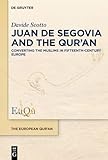Juan de Segovia and the Qur’an : Converting the Muslims in Fifteenth-Century Europe / Davide Scotto.
Material type: TextSeries: The European Qur'an ; 9Publisher: Berlin ; Boston : De Gruyter, [2024]Copyright date: 2024Description: 1 online resource (VII, 263 p.)Content type:
TextSeries: The European Qur'an ; 9Publisher: Berlin ; Boston : De Gruyter, [2024]Copyright date: 2024Description: 1 online resource (VII, 263 p.)Content type: - 9783111438382
- 9783111443126
- 9783111442860
- 297.12
- online - DeGruyter
- Issued also in print.
| Item type | Current library | Call number | URL | Status | Notes | Barcode | |
|---|---|---|---|---|---|---|---|
 eBook
eBook
|
Biblioteca "Angelicum" Pont. Univ. S.Tommaso d'Aquino Nuvola online | online - DeGruyter (Browse shelf(Opens below)) | Online access | Not for loan (Accesso limitato) | Accesso per gli utenti autorizzati / Access for authorized users | (dgr)9783111442860 |
Frontmatter -- Contents -- Introduction Beyond Juan de Segovia, “Islamologist” and “Pacifist” -- Chapter 1 Teaching and Debates with the Muslims in Castile -- Chapter 2 The Latin Qur’an and the Council of Basel -- Chapter 3 Converting the Muslims via pacis et doctrine -- Chapter 4 Yça Gidelli and the Trilingual Edition of the Qur’an -- Chapter 5 The Conversion Plan in the Hands of the Papacy -- Conclusions. Translating, Understanding, Converting -- Bibliography -- Index of Names
restricted access online access with authorization star
http://purl.org/coar/access_right/c_16ec
In spring 1456, with the help of the faqīh Yça Gidelli, Juan de Segovia accomplished a trilingual Qur’an (Castilian, Arabic and Latin) he regarded as fundamental to the conversion of the Muslims after the Ottoman conquest of Byzantium. This book delves into Segovia’s program, from his university lectures at Salamanca to the disputes held with Muslims in Castile, from the doctrinal debates at the Council of Basel to his exile in the Duchy of Savoy and the destiny of his books. Segovia deemed the await of miracles, preaching in Islamic lands, and the Crusade promoted by the papacy, to be useless. On the contrary, he considered knowledge of the Qur'an as unavoidable for Christian scholars engaged in the study of Islam, but also for Muslims, who were supposed to understand Christian doctrine through their own "law". It will be shown how Segovia's proposal is far from echoing modern concerns for religious tolerance, pacifism, and Arabic studies, let alone twentieth-century interreligious dialogue. Drawing on Biblical exegesis, Segovia called his program via pacis et doctrine and discussed it with influential churchmen such as Nicholas of Cusa and Enea Silvio Piccolomini. He believed mutual exchange of doctrinal ideas to be the only solution to stem wars and persuade Muslims to convert voluntarily to the Christian faith.
Issued also in print.
Mode of access: Internet via World Wide Web.
In English.
Description based on online resource; title from PDF title page (publisher's Web site, viewed 20. Nov 2024)


